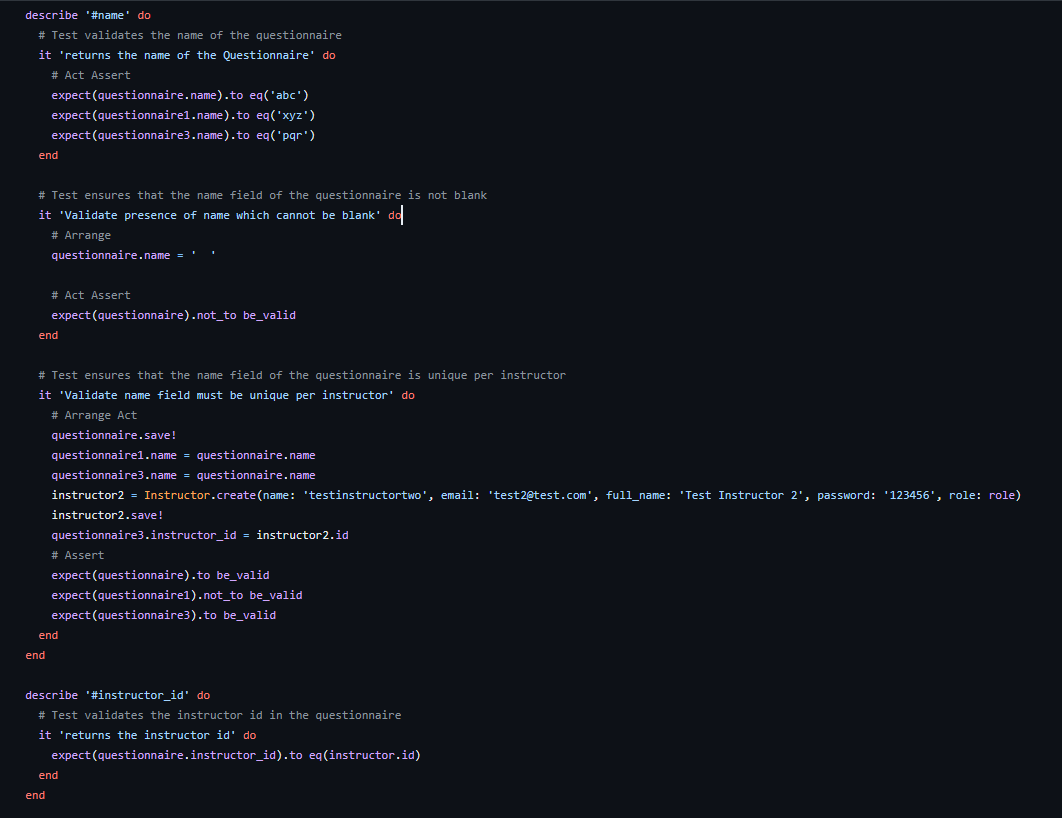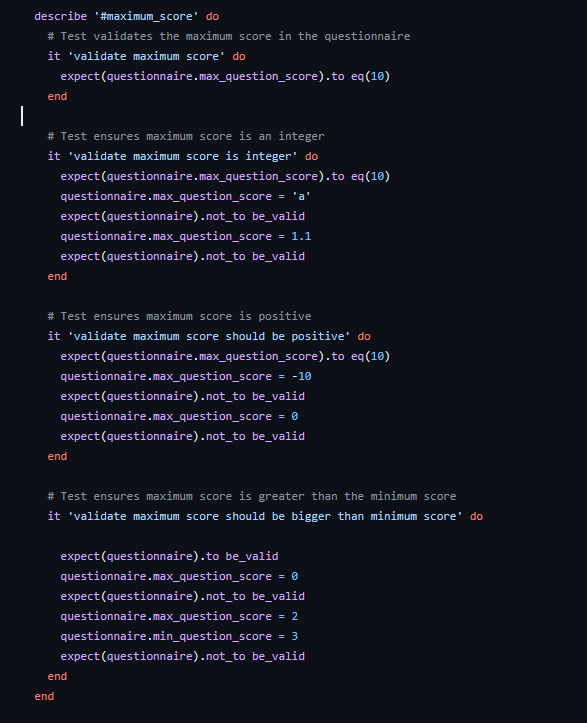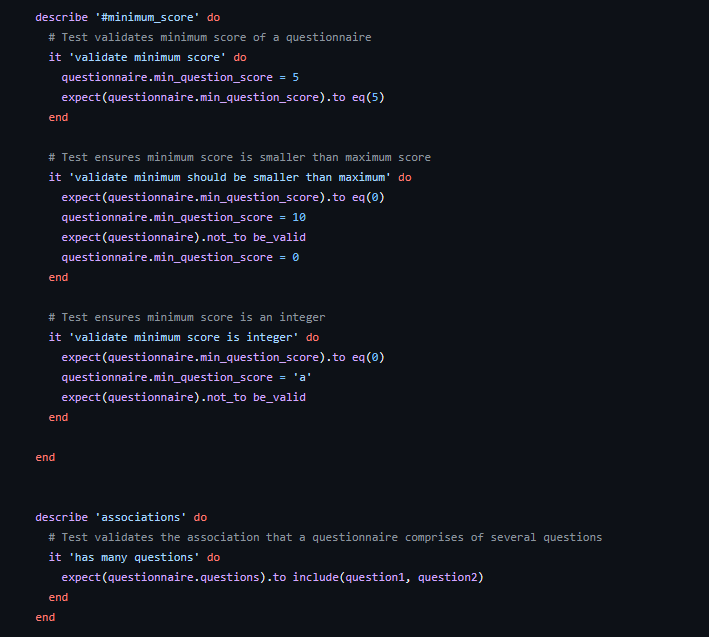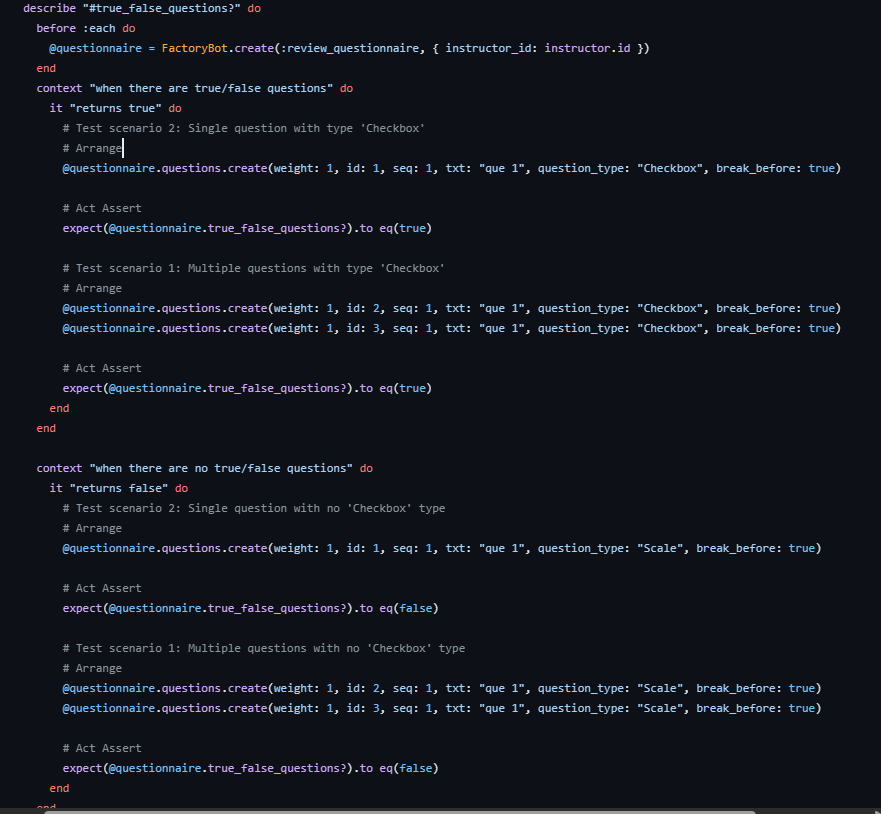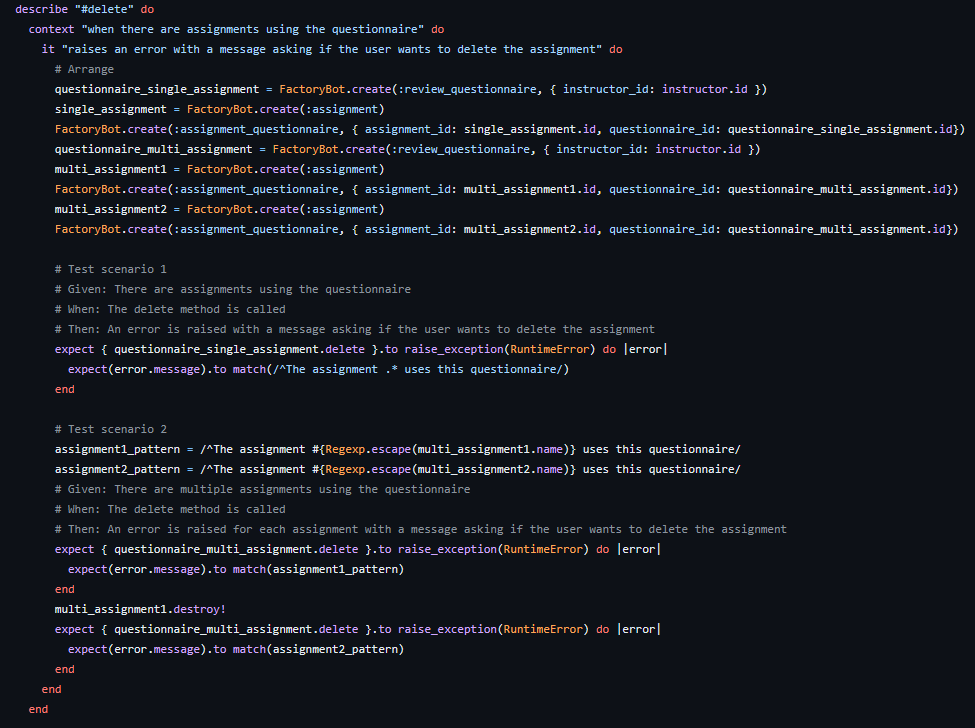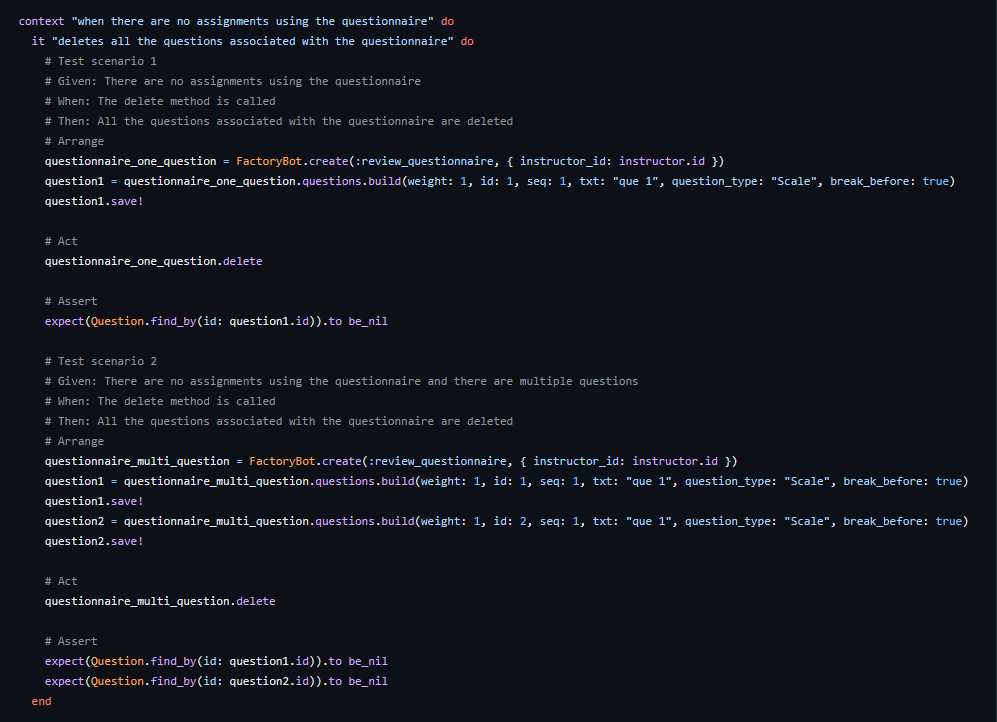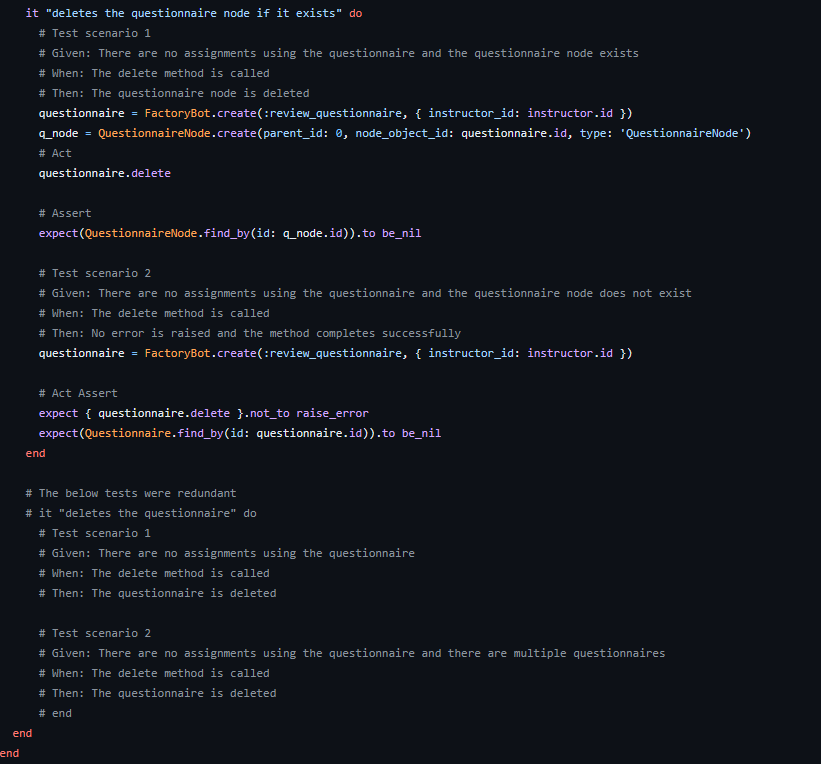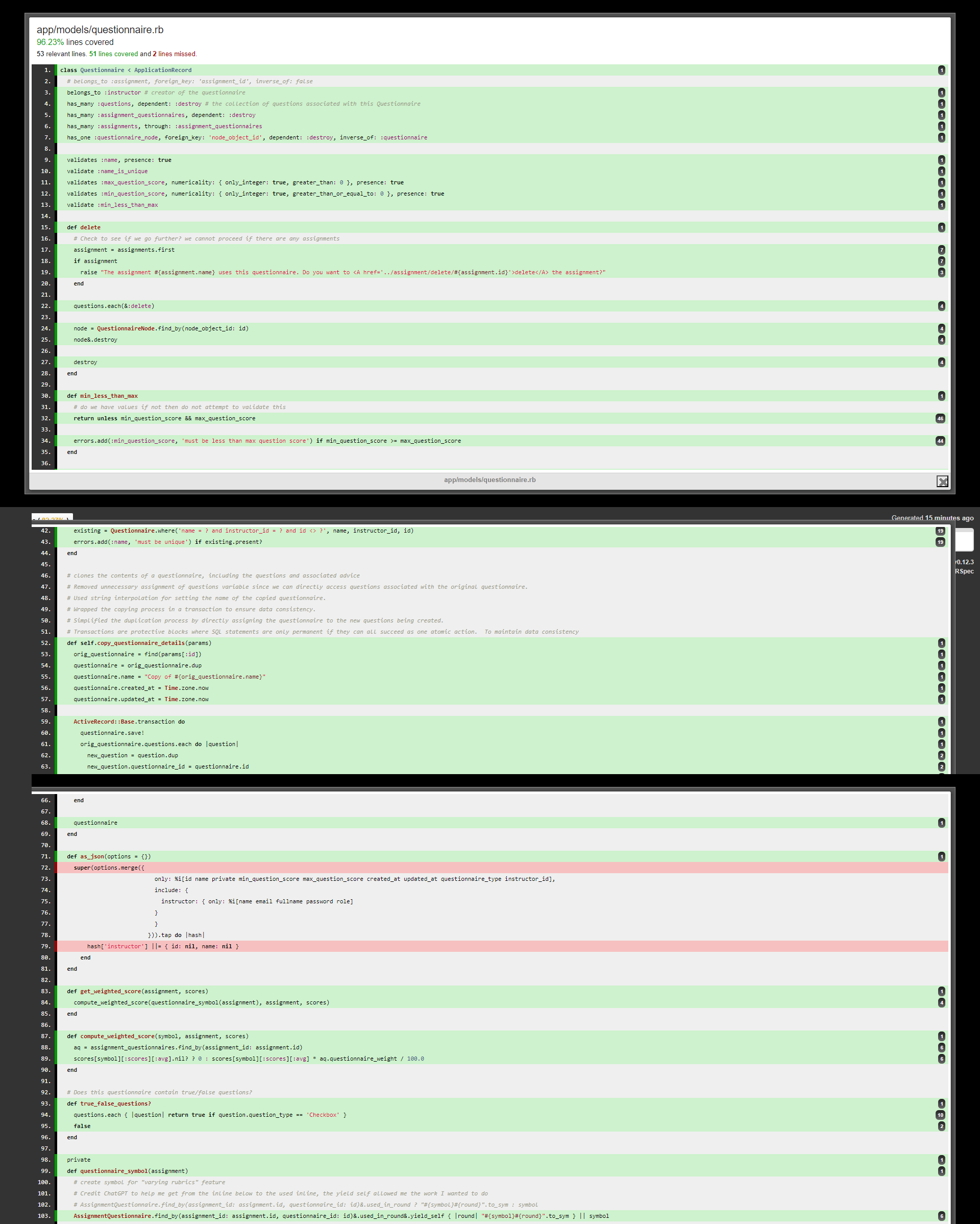E2422. Reimplement questionnaire.rb: Difference between revisions
No edit summary |
|||
| (60 intermediate revisions by 3 users not shown) | |||
| Line 25: | Line 25: | ||
errors.add(:name, 'Questionnaire names must be unique.') if results.present? | errors.add(:name, 'Questionnaire names must be unique.') if results.present? | ||
end | end | ||
end | end | ||
'''After refactoring''' | '''After refactoring''' | ||
| Line 49: | Line 49: | ||
end | end | ||
The validate_questionnaire method was changed in order to follow the Single Responsibility Principle in the SOLID guidelines. Before refactoring, validate_questionnaire was responsible for checking max, min, and if the min was less than max. So, after refactoring, the methods are split up to accomplish one check in each method. This also helps the readability of the code as the checks are very clear. | |||
=== get_weighted_score === | === get_weighted_score === | ||
| Line 93: | Line 93: | ||
end | end | ||
I | I decided to change this into two public methods and one private method. Since the original get_weighted_score got the score and looked up the symbol to use I felt it violated the single use principle. I created a private method to do the lookup of the symbol to use on its own. I created an elegant line of code to attempt to find an assignment questionnaire and if not null and used in a round it yields the result to be used in the return value. If not then it will just use this symbol. I had this line but without the yield as I was attempting to get it doing what I wanted it to do. I asked chatGPT and it presented me with the yield statement which I then used. Now each method only does what it should, gets the results, computes the result, or evaluates the symbol. | ||
=== true_false_questions? === | === true_false_questions? === | ||
| Line 103: | Line 103: | ||
end | end | ||
This method was doing the job very succinctly already. | This method was doing the job very succinctly already. No direct changes were made to this method and the method was left as is. | ||
=== delete === | === delete === | ||
| Line 134: | Line 134: | ||
end | end | ||
There was no reason to do an each on the list if the first one was going to throw an exception already so that was altered to just get first. Also just doing a null check on the dereference to the destroy on questionnaire node was more succinct than doing an if. | |||
=== max_possible_score === | |||
''' Before refactoring''' | |||
def max_possible_score | |||
results = Questionnaire.joins('INNER JOIN questions ON questions.questionnaire_id = questionnaires.id') | |||
.select('SUM(questions.weight) * questionnaires.max_question_score as max_score') | |||
.where('questionnaires.id = ?', id) | |||
results[0].max_score | |||
end | |||
''' After refactoring''' | |||
def max_possible_score | |||
## Just return 0 if there are no questions; don't throw an error. | |||
return 0 if questions.empty? | |||
## Sums up the weight of all the questions. This is not necessarily 1. | |||
sum_of_weights = questions.sum{ | question| quesitons.weight} | |||
max_possible_score = sum_of_weights * max_possible_score | |||
end | |||
This refactoring is similar to [https://wiki.expertiza.ncsu.edu/index.php?title=CSC/ECE_517_Spring_2023_-_E2319._Reimplement_questionnaire.rb E2319. Reimplement questionnaire.rb]. Instead of using the complicated SQL query, this should be easier to understand and is rather straightforward. Additionally, comments were added to improve the readability of the code. Adding the error check at the beginning should make the code slightly more robust in the case of questionnaires with no questions, and the variable names have been changed for clarity. | |||
=== copy_questionnaire_details === | === copy_questionnaire_details === | ||
| Line 140: | Line 162: | ||
''' Before refactoring''' | ''' Before refactoring''' | ||
def | def self.copy_questionnaire_details(params) | ||
orig_questionnaire = Questionnaire.find(params[:id]) | |||
questions = Question.where(questionnaire_id: params[:id]) | |||
questionnaire = orig_questionnaire.dup | |||
questionnaire.name = 'Copy of ' + orig_questionnaire.name | |||
questionnaire.created_at = Time.zone.now | |||
questionnaire.updated_at = Time.zone.now | |||
questionnaire.save! | |||
questions.each do |question| | |||
new_question = question.dup | |||
new_question.questionnaire_id = questionnaire.id | |||
new_question.save! | |||
end | |||
questionnaire | |||
end | |||
''' After refactoring ''' | |||
def self.copy_questionnaire_details(params) | |||
orig_questionnaire = find(params[:id]) | |||
questionnaire = orig_questionnaire.dup | |||
questionnaire.name = "Copy of #{orig_questionnaire.name}" | |||
questionnaire.created_at = Time.zone.now | |||
questionnaire.updated_at = Time.zone.now | |||
ActiveRecord::Base.transaction do | |||
questionnaire.save! | |||
orig_questionnaire.questions.each do |question| | |||
new_question = question.dup | |||
new_question.questionnaire_id = questionnaire.id | |||
new_question.save! | |||
end | |||
end | end | ||
questionnaire | |||
end | end | ||
This method handles copying a questionnaire and its attributes and dependencies in the model structure. We find the questionnaire to copy from the database and assign it to orig_questionnaire. In the original code, they used a questions variable to access different questions associated with the original questionnaire. However, we can directly access the questions associated with a questionnaire with how the models are set up. So, it has been eliminated when reimplementing the method. String interpolation was used instead of string concatenation to improve readability and simplicity. It is also less error-prone when compared to concatenation. A big change in the implementation of this method is wrapping the copying process in a transaction. This is done to ensure data consistency. Active Record Transactions are protective blocks where SQL statements are only permanent if they can all succeed as one atomic action. (Ref. https://api.rubyonrails.org/classes/ActiveRecord/Transactions/ClassMethods.html) We started an ActiveRecord transaction to save this new questionnaire and to duplicate the questions associated with the original questionnaire. | |||
== Required migrations == | == Required migrations == | ||
| Line 407: | Line 456: | ||
end | end | ||
=== Questionnaire model === | |||
---- | |||
Some of the variables that we will need in all or nearly all tests we have declared at the top within the whole describe for the Questionnaire class tests. | |||
[[File:Rspec-header.png]] | |||
=== Validate(s) === | === Validate(s) === | ||
---- | ---- | ||
The following list of tests are to assert all the validations for the class. Using the predefined factory variables we test validations. | |||
Are all names what we expect. Validate we cannot have a valid questionnaire without a name. Create two questionnaires with the same name and instructor to ensure we cannot save the second one. Also validate that the questionnaire returns the assigned instructors id. | |||
[[File:Validation 1.png]]</br></br> | |||
There are a few tests to run which can help us test the maximum_score method. We can make sure it matches what is expected, we can assert that alpha characters and floats are not valid. We can follow that up with tests to ensure it is a positive integer, and that the max is larger than the minimum. | |||
[[File:Validation 2.png]]</br></br> | |||
The final validations are minimum score and associations. The few tests for minimum score are to check that it is what it should be, that it is positive, and cannot be an alpha character. | |||
[[File:Validation 3.png]]</br></br> | |||
=== get_weighted_score === | === get_weighted_score === | ||
| Line 571: | Line 547: | ||
=== true_false_questions? === | === true_false_questions? === | ||
---- | ---- | ||
We decided to use before each to setup the questionnaire that we can use for the duration of this describe. For these the test the skeleton provided was used and the scenarios felt like complete tests. Testing both a single and multiple valid checkbox questions assert to true. We also want to validate that single or multiple non checkbox questions assert to false. | |||
[[File:True-false-rspec.png]] | |||
=== delete === | === delete === | ||
---- | ---- | ||
'''''The | [[File:Delete-rspec-1.png]]</br></br> | ||
It is important to test that deleting a questionnaire also deletes all the questions associated with that questionnaire. In this case we test two situations, first we need to test just one question on the questionnaire, and then multiple questions on the questionnaire. | |||
[[File:Delete-rspec-2.png]]</br></br> | |||
For the last parts of delete testing I used 2 more of the test skeletons. There are two scenarios to test in relation to the question node associated to a questionnaire. We should assert that questions are deleted with and without an associated node, and that the questionnaire node does not exist any longer in the case where there was an associated node. | |||
[[File:Delete-rspec-3.png]]</br></br> | |||
=== copy_questionnaire_details === | |||
---- | |||
[[File:Copy_questionnaire_test.png]]<br><br> | |||
The tests for this method were implemented correctly and they covered most of the functionalities of this particular function. | |||
The first set of tests checks the method calls from copy_questionnaire_details. The first line stubs the 'find' method of the Questionnaire model. The second line stubs the 'where' method of the Questionnaire model. The first test stubs the find method to return a mock 'questionnaire' object when called with argument 1. The second test looks for an array containing a 'question' object when called with questionnaire ID as an argument. | |||
The second set of tests checks the copying process of the copy_questionnaire_details method. In the original code, they had two different tests for it. One is to see if the new questionnaire is saved in the database and a separate test is used to check for proper associations of questions in the new questionnaire. We have combined these tests to avoid rerunning the same tests to retrieve migration data from the database. Our tests cover almost all the functionalities provided in the suggested skeleton for the test files. | |||
The first line of the second set of tests checks if the method yields 'question1' and 'question2' when questions.each is called, checking the associations between the 'questionnaire' model and the 'question' model. | |||
We are checking the consistencies of the copied data by comparing instructor ID, copied questionnaire name, and time of creation/copying. We are also checking the associations of the copied questionnaire with the 'question' model by checking the count of these copied questions and each particular question file by comparing its file type and ID. | |||
Overall, these tests ensure that the copy_questionnaire_details method correctly creates a copy of a given questionnaire, including its associated questions, and that certain method calls are made within the method. | |||
=== The below tests were redundant === | |||
---- | |||
These two tests were part of the test skeleton but were redundant, so we did not include them. | |||
it "deletes the questionnaire" do | |||
#Test scenario 1 | |||
#Given: There are no assignments using the questionnaire | |||
#When: The delete method is called | |||
#Then: The questionnaire is deleted | |||
#Test scenario 2 | |||
#Given: There are no assignments using the questionnaire and there are multiple questionnaires | |||
#When: The delete method is called | |||
#Then: The questionnaire is deleted | |||
# Test scenario 2 | |||
# Given: There are no assignments using the questionnaire and there are multiple questionnaires | |||
# When: The delete method is called | |||
# Then: The questionnaire is deleted | |||
end | end | ||
=== SimpleCov Coverage Report === | |||
---- | |||
The SimpleCov report shows 96.23% relevant LoC for our questionnaire.rb model file. | |||
*'''https://adryne01.github.io/Prog3-SimpleCov/Code%20coverage%20for%20Reimplementation-back-end.html''' | |||
---- | |||
[[File:SimpleCov_Report.png]]<br><br> | |||
== Authors == | |||
This project was completed by Aiden Bartlett, Brandon Devine, and Aditya Karthikeyan. | |||
Latest revision as of 09:11, 27 March 2024
Problem Description
The project includes re-implementation of the questionnaire.rb found in Expertiza to the Reimplementation-back-end . The current implementation includes various functionalities such as validation checks and methods. The goal is to implement these ensuring the code follows SOLID principles and is DRY in nature.
Important points
- The new model should use rails in built active record validation and eliminate the Validate_questionnaire method.
- The model should check for any overlapping functionalities from the controller and ensure all business logic is present in the model only.
- Eliminate methods and fields from this model that are exclusively utilized in test files so that only the required changes to the model are merged into the main branch.
- Ruby naming conventions should be followed for each method.
- Tests should be performed using Rspec covering all necessary functionalities.
- Comments should be present for every new functionality that is added and ensure to avoid all mistakes mentioned in the checklist document.
- Simplification of code is possible in various functions such as get_weighted_score and compute_weighted_score. For more details check the PR which has changes and ideas used for the implementation by the last team working on it.
- There is already an existing model in the Reimplementation back end . However this is essentially a copy paste from expertiza. This was done by the team working on the controller last spring in 2023. All changes should be made to the same file. Starting from scratch in your fork will be the quickest way to ensure no mix up from the existing implementation.
Methods Reimplemented
Validate(s)
Before refactoring
def validate_questionnaire
errors.add(:max_question_score, 'The maximum question score must be a positive integer.') if max_question_score < 1
errors.add(:min_question_score, 'The minimum question score must be a positive integer.') if min_question_score < 0
errors.add(:min_question_score, 'The minimum question score must be less than the maximum.') if min_question_score >= max_question_score
results = Questionnaire.where('id <> ? and name = ? and instructor_id = ?', id, name, instructor_id)
errors.add(:name, 'Questionnaire names must be unique.') if results.present?
end
end
After refactoring
validates :name, presence: true
validate :name_is_unique
validates :max_question_score, numericality: { only_integer: true, greater_than: 0 }, presence: true
validates :min_question_score, numericality: { only_integer: true, greater_than_or_equal_to: 0 }, presence: true
validate :min_less_than_max
def name_is_unique
# return if we do not have all the values to check
return unless id && name && instructor_id
# check for existing named questionnaire for this instructor that is not this questionnaire
existing = Questionnaire.where('name = ? and instructor_id = ? and id <> ?', name, instructor_id, id)
errors.add(:name, 'must be unique') if existing.present?
end
def min_less_than_max # do we have values if not then do not attempt to validate this return unless min_question_score && max_question_score errors.add(:min_question_score, 'must be less than max question score') if min_question_score >= max_question_score end
The validate_questionnaire method was changed in order to follow the Single Responsibility Principle in the SOLID guidelines. Before refactoring, validate_questionnaire was responsible for checking max, min, and if the min was less than max. So, after refactoring, the methods are split up to accomplish one check in each method. This also helps the readability of the code as the checks are very clear.
get_weighted_score
Before refactoring
def get_weighted_score(assignment, scores)
# create symbol for "varying rubrics" feature -Yang
round = AssignmentQuestionnaire.find_by(assignment_id: assignment.id, questionnaire_id: id).used_in_round
questionnaire_symbol = if round.nil?
symbol
else
(symbol.to_s + round.to_s).to_sym
end
compute_weighted_score(questionnaire_symbol, assignment, scores)
end
def compute_weighted_score(symbol, assignment, scores)
aq = assignment_questionnaires.find_by(assignment_id: assignment.id)
if scores[symbol][:scores][:avg].nil?
0
else
scores[symbol][:scores][:avg] * aq.questionnaire_weight / 100.0
end
end
After refactoring
def get_weighted_score(assignment, scores) compute_weighted_score(questionnaire_symbol(assignment), assignment, scores) end
def compute_weighted_score(symbol, assignment, scores) aq = assignment_questionnaires.find_by(assignment_id: assignment.id) scores[symbol][:scores][:avg].nil? ? 0 : scores[symbol][:scores][:avg] * aq.questionnaire_weight / 100.0 end
def questionnaire_symbol(assignment)
# create symbol for "varying rubrics" feature
# Credit ChatGPT to help me get from the inline below to the used inline, the yield self allowed me the work I wanted to do
# AssignmentQuestionnaire.find_by(assignment_id: assignment.id, questionnaire_id: id)&.used_in_round ? "#{symbol}#{round}".to_sym : symbol
AssignmentQuestionnaire.find_by(assignment_id: assignment.id, questionnaire_id: id)&.used_in_round&.yield_self { |round| "#{symbol}#{round}".to_sym } || symbol
end
I decided to change this into two public methods and one private method. Since the original get_weighted_score got the score and looked up the symbol to use I felt it violated the single use principle. I created a private method to do the lookup of the symbol to use on its own. I created an elegant line of code to attempt to find an assignment questionnaire and if not null and used in a round it yields the result to be used in the return value. If not then it will just use this symbol. I had this line but without the yield as I was attempting to get it doing what I wanted it to do. I asked chatGPT and it presented me with the yield statement which I then used. Now each method only does what it should, gets the results, computes the result, or evaluates the symbol.
true_false_questions?
def true_false_questions?
questions.each { |question| return true if question.type == 'Checkbox' }
false
end
This method was doing the job very succinctly already. No direct changes were made to this method and the method was left as is.
delete
Before refactoring
def delete
assignments.each do |assignment|
raise "The assignment #{assignment.name} uses this questionnaire.
Do you want to <A href='../assignment/delete/#{assignment.id}'>delete</A> the assignment?"
end
questions.each(&:delete)
node = QuestionnaireNode.find_by(node_object_id: id)
node.destroy if node
destroy
end
After refactoring
def delete
# Check to see if we go further? we cannot proceed if there are any assignments
assignment = assignments.first
if assignment
raise "The assignment #{assignment.name} uses this questionnaire. Do you want to <A href='../assignment/delete/#{assignment.id}'>delete</A> the assignment?"
end
questions.each(&:delete)
node = QuestionnaireNode.find_by(node_object_id: id)
node&.destroy
destroy
end
There was no reason to do an each on the list if the first one was going to throw an exception already so that was altered to just get first. Also just doing a null check on the dereference to the destroy on questionnaire node was more succinct than doing an if.
max_possible_score
Before refactoring
def max_possible_score
results = Questionnaire.joins('INNER JOIN questions ON questions.questionnaire_id = questionnaires.id')
.select('SUM(questions.weight) * questionnaires.max_question_score as max_score')
.where('questionnaires.id = ?', id)
results[0].max_score
end
After refactoring
def max_possible_score
## Just return 0 if there are no questions; don't throw an error.
return 0 if questions.empty?
## Sums up the weight of all the questions. This is not necessarily 1.
sum_of_weights = questions.sum{ | question| quesitons.weight}
max_possible_score = sum_of_weights * max_possible_score
end
This refactoring is similar to E2319. Reimplement questionnaire.rb. Instead of using the complicated SQL query, this should be easier to understand and is rather straightforward. Additionally, comments were added to improve the readability of the code. Adding the error check at the beginning should make the code slightly more robust in the case of questionnaires with no questions, and the variable names have been changed for clarity.
copy_questionnaire_details
Before refactoring
def self.copy_questionnaire_details(params)
orig_questionnaire = Questionnaire.find(params[:id])
questions = Question.where(questionnaire_id: params[:id])
questionnaire = orig_questionnaire.dup
questionnaire.name = 'Copy of ' + orig_questionnaire.name
questionnaire.created_at = Time.zone.now
questionnaire.updated_at = Time.zone.now
questionnaire.save!
questions.each do |question|
new_question = question.dup
new_question.questionnaire_id = questionnaire.id
new_question.save!
end
questionnaire
end
After refactoring
def self.copy_questionnaire_details(params)
orig_questionnaire = find(params[:id])
questionnaire = orig_questionnaire.dup
questionnaire.name = "Copy of #{orig_questionnaire.name}"
questionnaire.created_at = Time.zone.now
questionnaire.updated_at = Time.zone.now
ActiveRecord::Base.transaction do
questionnaire.save!
orig_questionnaire.questions.each do |question|
new_question = question.dup
new_question.questionnaire_id = questionnaire.id
new_question.save!
end
end
questionnaire end
This method handles copying a questionnaire and its attributes and dependencies in the model structure. We find the questionnaire to copy from the database and assign it to orig_questionnaire. In the original code, they used a questions variable to access different questions associated with the original questionnaire. However, we can directly access the questions associated with a questionnaire with how the models are set up. So, it has been eliminated when reimplementing the method. String interpolation was used instead of string concatenation to improve readability and simplicity. It is also less error-prone when compared to concatenation. A big change in the implementation of this method is wrapping the copying process in a transaction. This is done to ensure data consistency. Active Record Transactions are protective blocks where SQL statements are only permanent if they can all succeed as one atomic action. (Ref. https://api.rubyonrails.org/classes/ActiveRecord/Transactions/ClassMethods.html) We started an ActiveRecord transaction to save this new questionnaire and to duplicate the questions associated with the original questionnaire.
Required migrations
The following migrations were required to bring the current reimplementation fork up to par with what was needed to match the Expertiza class.
class AddUsedInRoundToAssignmentQuestionnaire < ActiveRecord::Migration[7.0]
def self.up add_column 'assignment_questionnaires', 'used_in_round', :integer end def self.down remove_column 'assignment_questionnaires', 'used_in_round' end
end
class AddQuestionnarieWeightToAssignmentQuestionnaire < ActiveRecord::Migration[7.0]
def self.up add_column 'assignment_questionnaires', 'questionnaire_weight', :integer, default: 0, null: false end def self.down remove_column 'assignment_questionnaires', 'questionnaire_weight' end
end
class CreateNodes < ActiveRecord::Migration[7.0]
def self.up
create_table :nodes do |t|
t.column :parent_id, :integer
t.column :node_object_id, :integer
t.column :type, :string
end
end
def self.down drop_table :nodes end
end
Rspec Testing
Suggested test skeleton
# Here are the skeleton rspec tests to be implemented as well, or to replace existing duplicate tests
describe "#get_weighted_score" do
context "when the assignment has a round" do
it "computes the weighted score using the questionnaire symbol with the round appended" do
# Test case 1
# Given an assignment with an ID and a questionnaire with a symbol
# And the questionnaire is used in a round
# And a set of scores
# When the get_weighted_score method is called with the assignment and scores
# Then it should compute the weighted score using the questionnaire symbol with the round appended
# Test case 2
# Given an assignment with an ID and a questionnaire with a symbol
# And the questionnaire is used in a round
# And a different set of scores
# When the get_weighted_score method is called with the assignment and scores
# Then it should compute the weighted score using the questionnaire symbol with the round appended
end
end
context "when the assignment does not have a round" do
it "computes the weighted score using the questionnaire symbol" do
# Test case 3
# Given an assignment with an ID and a questionnaire with a symbol
# And the questionnaire is not used in a round
# And a set of scores
# When the get_weighted_score method is called with the assignment and scores
# Then it should compute the weighted score using the questionnaire symbol
# Test case 4
# Given an assignment with an ID and a questionnaire with a symbol
# And the questionnaire is not used in a round
# And a different set of scores
# When the get_weighted_score method is called with the assignment and scores
# Then it should compute the weighted score using the questionnaire symbol
end
end
end
describe "#compute_weighted_score" do
context "when the average score is nil" do
it "returns 0" do
# Test scenario
end
end
context "when the average score is not nil" do
it "calculates the weighted score based on the questionnaire weight" do
# Test scenario
end
end
end
describe "#true_false_questions?" do
context "when there are true/false questions" do
it "returns true" do
# Test scenario 1: Multiple questions with type 'Checkbox'
# Test scenario 2: Single question with type 'Checkbox'
end
end
context "when there are no true/false questions" do
it "returns false" do
# Test scenario 1: Multiple questions with no 'Checkbox' type
# Test scenario 2: Single question with no 'Checkbox' type
end
end
end
describe "#delete" do
context "when there are assignments using the questionnaire" do
it "raises an error with a message asking if the user wants to delete the assignment" do
# Test scenario 1
# Given: There are assignments using the questionnaire
# When: The delete method is called
# Then: An error is raised with a message asking if the user wants to delete the assignment
# Test scenario 2
# Given: There are multiple assignments using the questionnaire
# When: The delete method is called
# Then: An error is raised for each assignment with a message asking if the user wants to delete the assignment
end
end
context "when there are no assignments using the questionnaire" do
it "deletes all the questions associated with the questionnaire" do
# Test scenario 1
# Given: There are no assignments using the questionnaire
# When: The delete method is called
# Then: All the questions associated with the questionnaire are deleted
# Test scenario 2
# Given: There are no assignments using the questionnaire and there are multiple questions
# When: The delete method is called
# Then: All the questions associated with the questionnaire are deleted
end
it "deletes the questionnaire node if it exists" do
# Test scenario 1
# Given: There are no assignments using the questionnaire and the questionnaire node exists
# When: The delete method is called
# Then: The questionnaire node is deleted
# Test scenario 2
# Given: There are no assignments using the questionnaire and the questionnaire node does not exist
# When: The delete method is called
# Then: No error is raised and the method completes successfully
end
it "deletes the questionnaire" do
# Test scenario 1
# Given: There are no assignments using the questionnaire
# When: The delete method is called
# Then: The questionnaire is deleted
# Test scenario 2
# Given: There are no assignments using the questionnaire and there are multiple questionnaires
# When: The delete method is called
# Then: The questionnaire is deleted
end
end
end
describe "#max_possible_score" do
context "when the questionnaire has no questions" do
it "returns 0 as the maximum possible score" do
# test code
end
end
context "when the questionnaire has questions with different weights" do
it "returns the correct maximum possible score based on the weights and max_question_score" do
# test code
end
end
context "when the questionnaire has questions with the same weight" do
it "returns the correct maximum possible score based on the weight and max_question_score" do
# test code
end
end
context "when the questionnaire ID does not exist" do
it "returns nil as the maximum possible score" do
# test code
end
end
end
describe '.copy_questionnaire_details' do
context 'when given valid parameters' do
it 'creates a copy of the questionnaire with the instructor_id' do
# Test body
end
it 'sets the name of the copied questionnaire as "Copy of [original name]"' do
# Test body
end
it 'sets the created_at timestamp of the copied questionnaire to the current time' do
# Test body
end
it 'saves the copied questionnaire' do
# Test body
end
it 'creates copies of all the questions from the original questionnaire' do
# Test body
end
it 'sets the questionnaire_id of the copied questions to the id of the copied questionnaire' do
# Test body
end
it 'sets the size of the copied criterion and text response questions to "50,3" if size is nil' do
# Test body
end
it 'saves the copied questions' do
# Test body
end
it 'creates copies of all the question advices associated with the original questions' do
# Test body
end
it 'sets the question_id of the copied question advices to the id of the copied question' do
# Test body
end
it 'saves the copied question advices' do
# Test body
end
it 'returns the copied questionnaire' do
# Test body
end
end
end
describe "#validate_questionnaire" do
context "when the maximum question score is less than 1" do
it "should add an error message" do
# test code
end
end
context "when the minimum question score is less than 0" do
it "should add an error message" do
# test code
end
end
context "when the minimum question score is greater than or equal to the maximum question score" do
it "should add an error message" do
# test code
end
end
context "when a questionnaire with the same name and instructor already exists" do
it "should add an error message" do
# test code
end
end
end
Questionnaire model
Some of the variables that we will need in all or nearly all tests we have declared at the top within the whole describe for the Questionnaire class tests.
Validate(s)
The following list of tests are to assert all the validations for the class. Using the predefined factory variables we test validations. Are all names what we expect. Validate we cannot have a valid questionnaire without a name. Create two questionnaires with the same name and instructor to ensure we cannot save the second one. Also validate that the questionnaire returns the assigned instructors id.
There are a few tests to run which can help us test the maximum_score method. We can make sure it matches what is expected, we can assert that alpha characters and floats are not valid. We can follow that up with tests to ensure it is a positive integer, and that the max is larger than the minimum.
The final validations are minimum score and associations. The few tests for minimum score are to check that it is what it should be, that it is positive, and cannot be an alpha character.
get_weighted_score
describe '#get_weighted_score' do
before :each do
@questionnaire = FactoryBot.create(:review_questionnaire, { instructor_id: instructor.id })
@assignment = FactoryBot.create(:assignment)
end
context 'when the assignment has a round' do
it 'computes the weighted score using the questionnaire symbol with the round appended' do
# Test case 1
# Arrange
FactoryBot.create(:assignment_questionnaire, { assignment_id: @assignment.id, questionnaire_id: @questionnaire.id, used_in_round: 1 })
scores = { "#{@questionnaire.symbol}#{1}".to_sym => { scores: { avg: 100 } } }
# Act Assert
expect(@questionnaire.get_weighted_score(@assignment, scores)).to eq(100)
# Test case 2
# Arrange
scores = { "#{@questionnaire.symbol}#{1}".to_sym => { scores: { avg: 75 } } }
# Act Assert
expect(@questionnaire.get_weighted_score(@assignment, scores)).to eq(75)
end
end
context 'when the assignment does not have a round' do
it 'computes the weighted score using the questionnaire symbol' do
# Test case 3
# Arrange
FactoryBot.create(:assignment_questionnaire, { assignment_id: @assignment.id, questionnaire_id: @questionnaire.id })
scores = { @questionnaire.symbol => { scores: { avg: 100 } } }
# Act Assert
expect(@questionnaire.get_weighted_score(@assignment, scores)).to eq(100)
# Test case 4
# Arrange
scores = { @questionnaire.symbol => { scores: { avg: 75 } } }
# Act Assert
expect(@questionnaire.get_weighted_score(@assignment, scores)).to eq(75)
end
end
describe "#compute_weighted_score" do
before :each do
@questionnaire = FactoryBot.create(:review_questionnaire, { instructor_id: instructor.id })
@assignment = FactoryBot.create(:assignment)
FactoryBot.create(:assignment_questionnaire, { assignment_id: @assignment.id, questionnaire_id: @questionnaire.id, questionnaire_weight: 50 })
end
context "when the average score is nil" do
it "returns 0" do
# Test scenario
# Arrange
scores = { @questionnaire.symbol => { scores: { avg: nil } } }
# Act Assert
expect(@questionnaire.compute_weighted_score(@questionnaire.symbol, @assignment, scores)).to eq(0)
end
end
context "when the average score is not nil" do
it "calculates the weighted score based on the questionnaire weight" do
# Test scenario
# Arrange
scores = { @questionnaire.symbol => { scores: { avg: 75 } } }
# Act Assert
expect(@questionnaire.compute_weighted_score(@questionnaire.symbol, @assignment, scores)).to eq(75 * 0.5)
end
end
end
end
true_false_questions?
We decided to use before each to setup the questionnaire that we can use for the duration of this describe. For these the test the skeleton provided was used and the scenarios felt like complete tests. Testing both a single and multiple valid checkbox questions assert to true. We also want to validate that single or multiple non checkbox questions assert to false.
delete
It is important to test that deleting a questionnaire also deletes all the questions associated with that questionnaire. In this case we test two situations, first we need to test just one question on the questionnaire, and then multiple questions on the questionnaire.
For the last parts of delete testing I used 2 more of the test skeletons. There are two scenarios to test in relation to the question node associated to a questionnaire. We should assert that questions are deleted with and without an associated node, and that the questionnaire node does not exist any longer in the case where there was an associated node.
copy_questionnaire_details
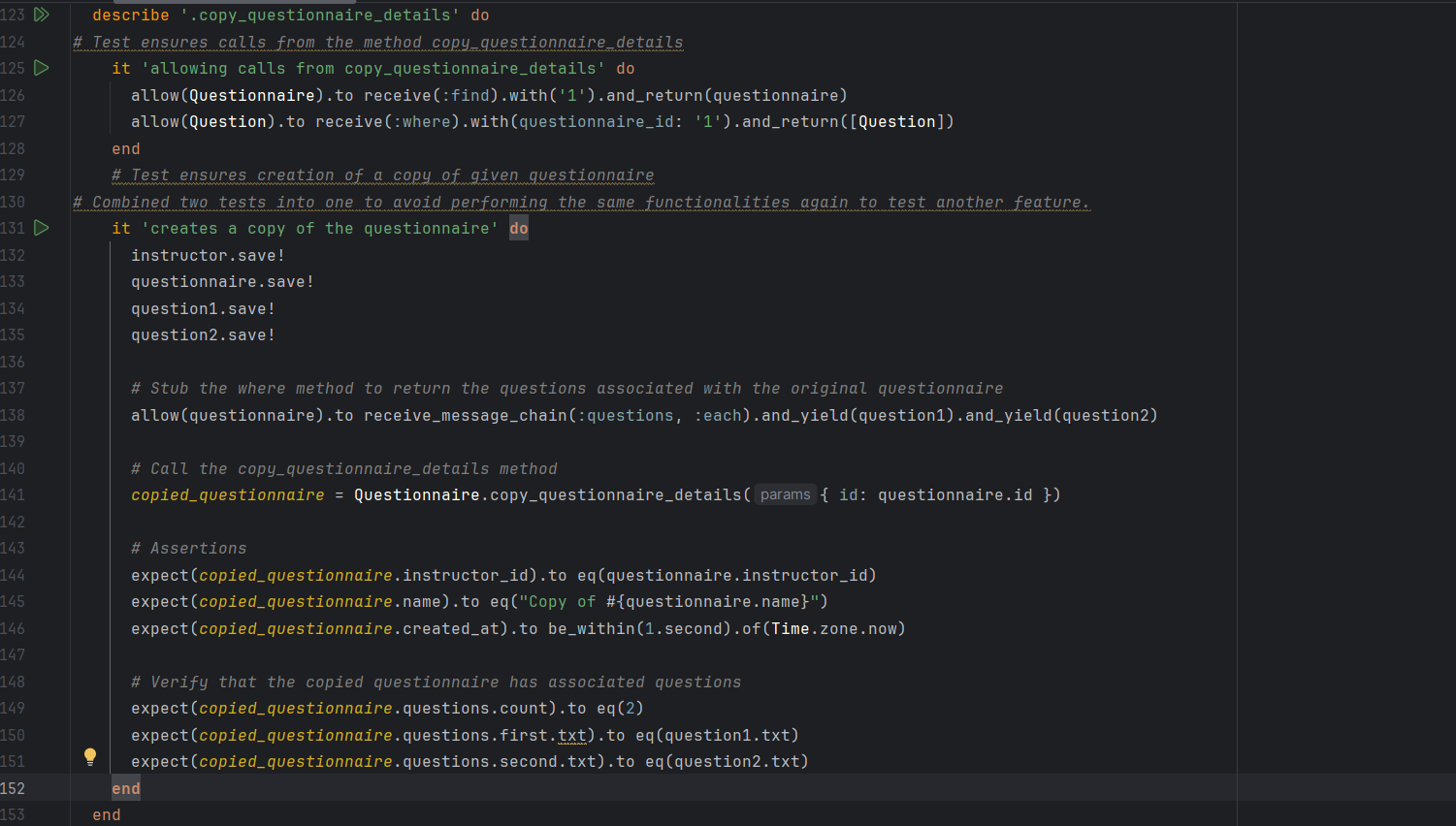
The tests for this method were implemented correctly and they covered most of the functionalities of this particular function.
The first set of tests checks the method calls from copy_questionnaire_details. The first line stubs the 'find' method of the Questionnaire model. The second line stubs the 'where' method of the Questionnaire model. The first test stubs the find method to return a mock 'questionnaire' object when called with argument 1. The second test looks for an array containing a 'question' object when called with questionnaire ID as an argument.
The second set of tests checks the copying process of the copy_questionnaire_details method. In the original code, they had two different tests for it. One is to see if the new questionnaire is saved in the database and a separate test is used to check for proper associations of questions in the new questionnaire. We have combined these tests to avoid rerunning the same tests to retrieve migration data from the database. Our tests cover almost all the functionalities provided in the suggested skeleton for the test files.
The first line of the second set of tests checks if the method yields 'question1' and 'question2' when questions.each is called, checking the associations between the 'questionnaire' model and the 'question' model.
We are checking the consistencies of the copied data by comparing instructor ID, copied questionnaire name, and time of creation/copying. We are also checking the associations of the copied questionnaire with the 'question' model by checking the count of these copied questions and each particular question file by comparing its file type and ID.
Overall, these tests ensure that the copy_questionnaire_details method correctly creates a copy of a given questionnaire, including its associated questions, and that certain method calls are made within the method.
The below tests were redundant
These two tests were part of the test skeleton but were redundant, so we did not include them.
it "deletes the questionnaire" do
#Test scenario 1
#Given: There are no assignments using the questionnaire
#When: The delete method is called
#Then: The questionnaire is deleted
#Test scenario 2
#Given: There are no assignments using the questionnaire and there are multiple questionnaires
#When: The delete method is called
#Then: The questionnaire is deleted
end
SimpleCov Coverage Report
The SimpleCov report shows 96.23% relevant LoC for our questionnaire.rb model file.
Authors
This project was completed by Aiden Bartlett, Brandon Devine, and Aditya Karthikeyan.

